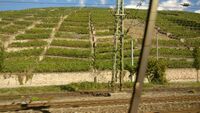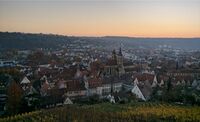Assignment 2: Your Landscape Symbols (2019): Difference between revisions
(Created page with "'''-->''' Back to Assignments Overview == Time frame == April 3 - April 24, 2019 == Task Description == *In this assignment, you a...") |
Anna.volken (talk | contribs) No edit summary |
||
| Line 22: | Line 22: | ||
*'''April 17 - 24, 2019''': Reflect with your team about each other’s symbols and how you perceive them, what are the similarities and differences in your perceptions? | *'''April 17 - 24, 2019''': Reflect with your team about each other’s symbols and how you perceive them, what are the similarities and differences in your perceptions? | ||
*'''April 24, 2019''': As a group, present your findings in the plenary, please use [https://ilias.hfwu.de/goto.php?target=file_20482_download&client_id=hfwu this template] for your presentation | *'''April 24, 2019''': As a group, present your findings in the plenary, please use [https://ilias.hfwu.de/goto.php?target=file_20482_download&client_id=hfwu this template] for your presentation | ||
<gallery caption=" " widths="200px" heights="150px" perrow="3"> | |||
Image:ANNA VOLKEN ASSIGNMENT 2.jpg|Picture 1: 48°44’32.85”N 9°18’27.80”E I chose the old Rathaus because, first of all, it is an imposing building in the historical city center of Esslingen - which contains some of the oldest constructions in Germany. That is possible thanks to fact that the city suffered no significant destruction during the Second World War - so it can be seen as an "architecture resistence symbol" through times of bombs and suffering. I see it also as an expression of a local identity. The Old Rathaus was built around 1420 and it has an eagle on its top, the animal that symbolizes freedom. On the occasion of a renovation, in 1926, there were expressive donations, including bells, by the citizens - showing the importance of the building to local people. | |||
Image:WhatsApp Image 2019-04-07 at 15.22.46.jpeg|Picture 2: 48°44’35.51”N 9°17’38.76”E The vineyards offer interesting views over the trajectory of the train to/from Stuttgart and awaken a desire to try the local wines. Besides that, this landscape provides the basis for recreational opportunities, like the Vineyard Walk, when people really interact with the landscape. | |||
Image:Picture3.jpg|Picture 3: 48°44’43.19”N 9°18’35.38”E Esslingen Castle is a preserved part of the medieval city fortification, which is located above the former and present-day city center. I chose the beautiful view it offers and it is important to say that the entrance is free, which invites not only visitors but residents to just enjoy a nice walk. | |||
</gallery> | |||
== Evaluation Criteria == | == Evaluation Criteria == | ||
Revision as of 20:28, 15 April 2019
--> Back to Assignments Overview
Time frame
April 3 - April 24, 2019
Task Description
- In this assignment, you are invited to identify features in your every-day surroundings that you believe have symbolic meaning and to interpret that symbolism. The task employs a method called “photovoice” which uses pictures to identify particular landscapes and their symbolic nature. You will identify and take pictures of three landscapes, which hold peculiar meaning in terms of landscape democracy.
- For each picture, you will develop a caption that will seek to explain what these symbol(s) mean in the context of Landscape & Democracy. Examples of landscapes holding a symbolic values might be depicting sculptures or memorials referring to historical or political events, etc. Symbolic meaning can also be inherent in architectural/urban form. For example, a building or open space might symbolize changes that have taken place at certain times either because it reflects the identity of a long lost community or because they embody a new identity.
- Often, these symbols and meanings came into being during specific moments in time and reflected a particular power structure or set of cultural assumption. Power structures may be changing while symbols are either maintained, or removed, or reinterpreted. On the other hand, symbols can also appear outside of conventional power structures, spontaneously created, representing alternative approaches to mainstream ideas.
The following questions should be kept in mind as you approach this photovoice assignment:
- How and why did the symbols you identify appear in your surroundings?
- Did their meaning change along with socio-political changes in your region, or country?
- What do these symbols mean to you today? Are they understandable for someone outside of your own culture?
- What do you think about sharing symbolic meanings of landscape?
Sequence of activities
- April 3 - April 10, 2019: Identify and take pictures of three landscape symbols in your surroundings. Upload at least one representative image to the seminar wiki. We will look at it during the session collectively.
- April 10 - 17, 2019:
- Complete your assignment by posting additional pictures on the wiki using the template introduced in class. You will need to add a caption (one paragraph max) description of their symbolism, interpretation, as well as geo-location. The pictures should be your own (no downloading from the web).
- If you do not have a phone or digital camera, you can draw pictures or sketches of these symbolic landscapes.
- April 17 - 24, 2019: Reflect with your team about each other’s symbols and how you perceive them, what are the similarities and differences in your perceptions?
- April 24, 2019: As a group, present your findings in the plenary, please use this template for your presentation
Picture 1: 48°44’32.85”N 9°18’27.80”E I chose the old Rathaus because, first of all, it is an imposing building in the historical city center of Esslingen - which contains some of the oldest constructions in Germany. That is possible thanks to fact that the city suffered no significant destruction during the Second World War - so it can be seen as an "architecture resistence symbol" through times of bombs and suffering. I see it also as an expression of a local identity. The Old Rathaus was built around 1420 and it has an eagle on its top, the animal that symbolizes freedom. On the occasion of a renovation, in 1926, there were expressive donations, including bells, by the citizens - showing the importance of the building to local people.
Picture 2: 48°44’35.51”N 9°17’38.76”E The vineyards offer interesting views over the trajectory of the train to/from Stuttgart and awaken a desire to try the local wines. Besides that, this landscape provides the basis for recreational opportunities, like the Vineyard Walk, when people really interact with the landscape.
Picture 3: 48°44’43.19”N 9°18’35.38”E Esslingen Castle is a preserved part of the medieval city fortification, which is located above the former and present-day city center. I chose the beautiful view it offers and it is important to say that the entrance is free, which invites not only visitors but residents to just enjoy a nice walk.
Evaluation Criteria
- Uploading and formatting of pictures and captions related to landscape symbol(s) on the wiki
- Use of original materials and images (taken by yourself in your own landscape context), no copy-paste from online resources (!)
- Differentiated reflection (social, historical, political, religious…)
- Quality of oral presentation (i.e. keeping time limits, clarity, expression, quality of presentation slides


